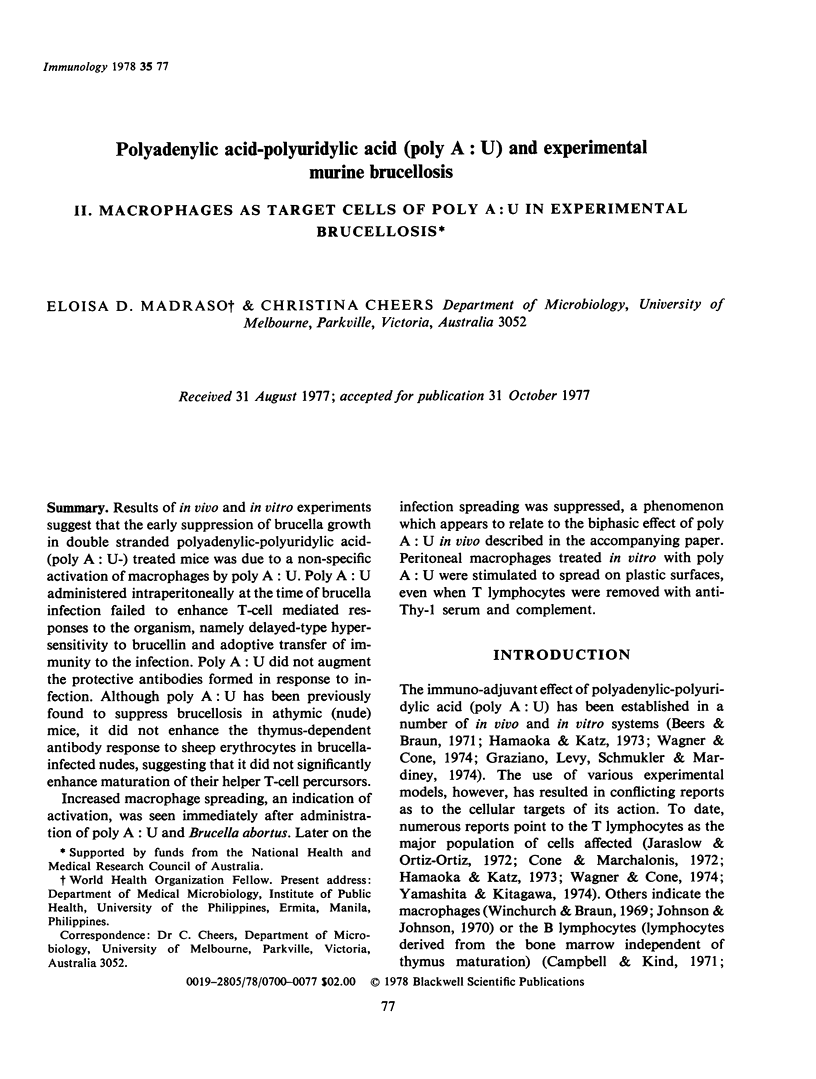Abstract
Results of in vivo and in vitro experiments suggest that the early suppression of brucella growth in double stranded polyadenylic-polyuridylic acid-(poly A:U-) treated mice was due to a non-specific activation of macrophages by poly A:U. Poly A:U administered intraperitoneally at the time of brucella infection failed to enhance T-cell mediated responses to the organism, namely delayed-type hyper-sensitivity to brucellin and adoptive transfer of immunity to the infection. Poly A:U did not augment the protective antibodies formed in response to infection. Although poly A:U has been previously found to suppress brucellosis in athymic (nude) mice, it did not enhance the thymus-dependent antibody response to sheep erythrocytes in brucella-infected nudes, suggesting that it did not significantly enhance maturation of their helper T-cell percursors.
Increased macrophage spreading, an indication of activation, was seen immediately after administration of poly A:U and Brucella abortus. Later on the infection spreading was suppressed, a phenomenon which appears to relate to the biphasic effect of poly A:U in vivo described in the accompanying paper. Peritoneal macrophages treated in vitro with poly A:U were stimulated to spread on plastic surfaces, even when T lymphocytes were removed with anti-Thy-1 serum and complement.
Full text
PDF







Selected References
These references are in PubMed. This may not be the complete list of references from this article.
- Bhongbhibhat N., Elberg S., Chen T. H. Characterization of brucella skin-test antigens. J Infect Dis. 1970 Jul-Aug;122(1):70–82. doi: 10.1093/infdis/122.1-2.70. [DOI] [PubMed] [Google Scholar]
- Boyle W. An extension of the 51Cr-release assay for the estimation of mouse cytotoxins. Transplantation. 1968 Sep;6(6):761–764. doi: 10.1097/00007890-196809000-00002. [DOI] [PubMed] [Google Scholar]
- Campbell P. A., Kind P. Bone marrow-derived cells as target cells for polynucleotide adjuvants. J Immunol. 1971 Nov;107(5):1419–1423. [PubMed] [Google Scholar]
- Cheers C., Cone R. E. Effect of polyadenine: polyuridine on brucellosis in conventional and congenitally athymic mice. J Immunol. 1974 Apr;112(4):1535–1539. [PubMed] [Google Scholar]
- Cone R. E., Marchalonis J. J. Adjuvant action of poly (A-U) on T-cells during the primary immune response in vitro. Aust J Exp Biol Med Sci. 1972 Feb;50(1):69–77. doi: 10.1038/icb.1972.6. [DOI] [PubMed] [Google Scholar]
- Cunningham A. J., Szenberg A. Further improvements in the plaque technique for detecting single antibody-forming cells. Immunology. 1968 Apr;14(4):599–600. [PMC free article] [PubMed] [Google Scholar]
- GRAY D. F., JENNINGS P. A. Allergy in experimental mouse tuberculosis. Am Rev Tuberc. 1955 Aug;72(2):171–195. doi: 10.1164/artpd.1955.72.2.171. [DOI] [PubMed] [Google Scholar]
- Graziano K. D., Levy C. C., Schmukler M., Mardiney M. R., Jr Parameters for effective use of synthetic double stranded polynucleotides in the amplification of immunologically induced lymphocyte tritiated thymidine incorporation. Cell Immunol. 1974 Mar 30;11(1-3):47–56. doi: 10.1016/0008-8749(74)90005-7. [DOI] [PubMed] [Google Scholar]
- Hamaoka T., Katz D. H. Mechanism of adjuvant activity of poly A:U on antibody responses to hapten-carrier conjugates. Cell Immunol. 1973 May;7(2):246–260. doi: 10.1016/0008-8749(73)90247-5. [DOI] [PubMed] [Google Scholar]
- Jaroslow B. N., Ortiz-Ortiz L. Influence of poly A-poly U on early events in the immune response in vitro. Cell Immunol. 1972 Jan;3(1):123–132. doi: 10.1016/0008-8749(72)90232-8. [DOI] [PubMed] [Google Scholar]
- Johnson H. G., Johnson A. G. Regulation of the immune system by synthetic polynucleotides. II. Action on peritoneal exudate cells. J Exp Med. 1971 Mar 1;133(3):649–664. doi: 10.1084/jem.133.3.649. [DOI] [PMC free article] [PubMed] [Google Scholar]
- LOWRY O. H., ROSEBROUGH N. J., FARR A. L., RANDALL R. J. Protein measurement with the Folin phenol reagent. J Biol Chem. 1951 Nov;193(1):265–275. [PubMed] [Google Scholar]
- Lefford M. J. Transfer of adoptive immunity to tuberculosis in mice. Infect Immun. 1975 Jun;11(6):1174–1181. doi: 10.1128/iai.11.6.1174-1181.1975. [DOI] [PMC free article] [PubMed] [Google Scholar]
- MACKANESS G. B. THE IMMUNOLOGICAL BASIS OF ACQUIRED CELLULAR RESISTANCE. J Exp Med. 1964 Jul 1;120:105–120. doi: 10.1084/jem.120.1.105. [DOI] [PMC free article] [PubMed] [Google Scholar]
- Nathan C. F., Remold H. G., David J. R. Characterization of a lymphocyte factor which alters macrophage functions. J Exp Med. 1973 Feb 1;137(2):275–290. doi: 10.1084/jem.137.2.275. [DOI] [PMC free article] [PubMed] [Google Scholar]
- North R. J. Cellular mediators of anti-Listeria immunity as an enlarged population of short lived, replicating T cells. Kinetics of their production. J Exp Med. 1973 Aug 1;138(2):342–355. doi: 10.1084/jem.138.2.342. [DOI] [PMC free article] [PubMed] [Google Scholar]
- North R. J. Suppression of cell-mediated immunity to infection by an antimitotic drug. Further evidence that migrant macrophages express immunity. J Exp Med. 1970 Sep 1;132(3):535–545. doi: 10.1084/jem.132.3.535. [DOI] [PMC free article] [PubMed] [Google Scholar]
- North R. J. The uptake of particulate antigens. J Reticuloendothel Soc. 1968 Jun;5(3):203–229. [PubMed] [Google Scholar]
- Scheid M. P., Hoffmann M. K., Komuro K., Hämmerling U., Abbott J., Boyse E. A., Cohen G. H., Hooper J. A., Schulof R. S., Goldstein A. L. Differentiation of T cells induced by preparations from thymus and by nonthymic agents. J Exp Med. 1973 Oct 1;138(4):1027–1032. doi: 10.1084/jem.138.4.1027. [DOI] [PMC free article] [PubMed] [Google Scholar]
- Stout R. D., Johnson A. G. Regulation of the immune system by synthetic polynucleotides. V. Effect on cell-associated immunoglobulin receptors and immunological memory. J Exp Med. 1972 Jan;135(1):45–67. doi: 10.1084/jem.135.1.45. [DOI] [PMC free article] [PubMed] [Google Scholar]
- Sulitzeanu D. Mechanism of immunity against brucella. Nature. 1965 Mar 13;205(976):1086–1088. doi: 10.1038/2051086a0. [DOI] [PubMed] [Google Scholar]
- Wagner H., Cone R. E. Adjuvant effect of poly(A:U) upon T cell-mediated in vitro cytotoxic allograft responses. Cell Immunol. 1974 Mar 15;10(3):394–403. doi: 10.1016/0008-8749(74)90131-2. [DOI] [PubMed] [Google Scholar]
- Winchurch R., Braun W. Antibody formation: premature initiation by endotoxin or synthetic polynucleotides in newborn mice. Nature. 1969 Aug 23;223(5208):843–844. doi: 10.1038/223843a0. [DOI] [PubMed] [Google Scholar]
- Yamashita U., Kitagawa M. Enhancing activity of synthetic polynucleotides on the induction of anti-hapten antibody response. Immunology. 1974 May;26(5):925–936. [PMC free article] [PubMed] [Google Scholar]
- Zinkernagel R. M., Blanden R. V., Langman R. E. Early appearance of sensitized lymphocytes in mice infected with Listeria monocytogenes. J Immunol. 1974 Feb;112(2):496–501. [PubMed] [Google Scholar]


